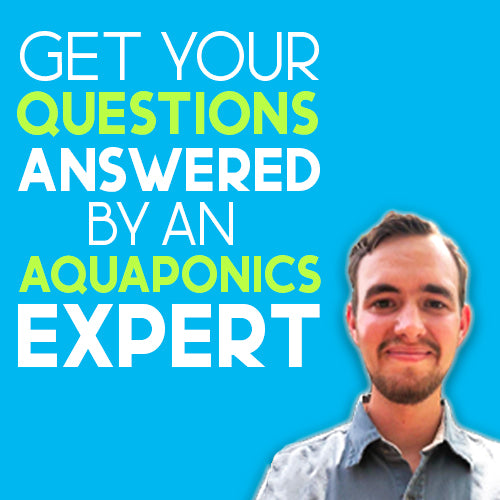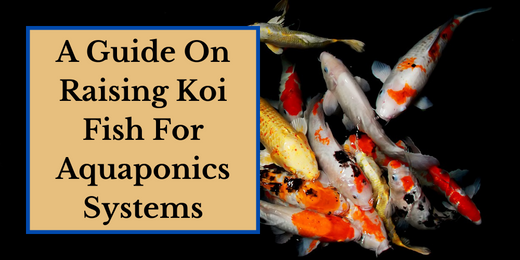Aquaponics offers plenty of methods or system design options perfect for anyone with limited space who wants to maximize their backyard for fresh produce. One, in particular, is the vertical aquaponics system.
A vertical aquaponics system is one method that grows plants without soil in columns above a fish tank. This method of aquaponics is popular with growers because it is a water-efficient and space-saving way to grow crops and raise fish. This article will discuss vertical aquaponics, its benefits, and how to start your vertical garden.
What is a Vertical Aquaponics System?
Imagine harvesting fresh herbs, leafy greens, and even fish, right from your balcony or small backyard. That’s not a fantasy. It’s vertical aquaponics, a space-saving, eco-friendly way to grow food in even the smallest of spaces.
So, what is a vertical aquaponics system?
It’s a type of aquaponics setup where the grow beds or planting areas are stacked vertically, often in towers or column-style units. This smart design combines hydroponics (growing plants without soil) and aquaculture (raising fish), all in a closed-loop system that recycles water and nutrients efficiently. The result? A highly productive food-growing method that uses up to 90% less water than traditional gardening and requires minimal ground space.
Vertical aquaponics is perfect for:
- Urban gardeners with limited space
- Beginners looking for an easy, scalable system
-
Anyone wanting a more sustainable way to grow their own food
This blog will walk you through:
- How vertical aquaponics works
- The benefits and challenges of the system
- What components do you need
- The best plants and fish to choose
- Real examples from beginners who’ve built successful systems
But if you’re looking to skip the trial and error and want a step-by-step, visual guide to setting up your own vertical aquaponics system, from sourcing materials to your first harvest.
Check out this premium aquaponics video course.
It’s beginner-friendly, budget-conscious, and designed to help you succeed.
How a Vertical Aquaponics System Works
Vertical aquaponics is a closed-loop ecosystem that mimics nature. Fish and plants work together in a symbiotic cycle, only this time, it’s neatly stacked upward to save space and water.
A Step-by-Step Breakdown of How Vertical Aquaponics Works
1. Fish Tank:
Fish like tilapia, goldfish, or koi are raised in a tank at the bottom of the system. As they live and grow, they produce waste (mostly ammonia).
2. Water Pump & Plumbing:
A small water pump moves the nutrient-rich fish water upward through vertical grow towers, often made of PVC pipes or food-safe plastic columns.
3. Biofiltration:
Beneficial bacteria in a biofilter convert fish waste into nitrates, a powerful natural fertilizer that plants love.
4. Plant Grow Beds:
As the water travels down through the vertical towers, it nourishes the plant roots (usually grown in net pots with clay pebbles). The plants absorb the nutrients and help clean the water.
5. Clean Water Returns to the Fish Tank:
The now-filtered water flows back into the fish tank, completing the cycle. No water is wasted. No chemicals are needed.
Common Vertical Designs
- NFT (Nutrient Film Technique): Narrow horizontal pipes stacked vertically. Great for leafy greens.
- Grow Towers:Cylindrical towers with slots for plants. Often used in urban settings or greenhouses.
-
Wall Units:Wall-mounted vertical gardens, ideal for indoor or patio spaces.
Benefits of Vertical Aquaponics for Urban Gardeners
If you’ve ever felt limited by the size of your backyard, or lack of one entirely, vertical aquaponics offers a breakthrough. It turns unused vertical space into a thriving, productive food system that fits almost anywhere.
Whether you’re growing in a small backyard, a sunny balcony, or even a corner of your kitchen, the vertical aquaponics system provides maximum yield with minimal space.
Top Benefits of Going Vertical with Aquaponics
1. Grow More in Less Space
- A single tower can hold dozens of plants, stacked upward instead of spreading out.
- Great for patios, rooftops, and indoor gardens where ground space is limited.
2. Uses Up to 90% Less Water Than Soil Gardening
- Water is constantly recirculated through the system.
- No need to water daily. No runoff or wasted irrigation.
3. Sustainable and Soil-Free
- No weeding, no soil-borne pests, and no chemical fertilizers.
- It’s a self-contained, eco-friendly solution perfect for those seeking a more sustainable lifestyle.
4. Faster Plant Growth & Year-Round Harvests
- With consistent nutrient flow and lighting (especially indoors), plants often grow 30–50% faster than in soil.
- Extend growing seasons with climate-controlled indoor setups.
5. Family- and Beginner-Friendly
- Kids love seeing the fish and plants grow together, making it a great educational tool.
- Ideal for beginners due to the low maintenance once set up properly
What You Need to Build a Vertical Aquaponics System
Let’s break down what you’ll need and how each part works together to keep your system thriving.
Components of a Vertical Aquaponics System
1. Fish Tank
The fish tank is the base of your system and the home for your fish.
- Size: A 20- to 55-gallon tank is common for small setups.
- Fish:Tilapia, koi, or goldfish are beginner-friendly options.
- Bonus Tip:Use a dark, food-safe container to prevent algae growth.
2. Water Pump & Plumbing
The pump moves water from the fish tank to the top of your vertical system. Gravity does the rest.
- Choose a submersible pump rated for continuous use.
- Use food-grade PVC or flexible tubing for plumbing.
- Add a check valve to prevent backflow and a timer if needed.
3. Vertical Grow Towers or NFT Pipes
This is where your plants grow. You’ll often see:
- PVC towers with side holes and net pots
- Nutrient Film Technique (NFT):horizontal tubes stacked vertically
- Towers can be DIY or pre-built systems like ZipGrow, Tower Garden, or custom pipe units
4. Grow Media
Helps support the plants and holds beneficial bacteria.
- Clay pebbles (hydroton) are the most common
- Alternatives: lava rock, gravel
- Net pots fit into the tower or pipe openings and hold the media
5. Biofilter (Optional but Recommended)
Converts fish waste (ammonia) into plant-usable nitrates.
- Can be built using a barrel or a small filter container
- Filled with media like bioballs or scrubbies
- Helps stabilize your system faster, especially in tight vertical setups
6. Lighting (for Indoor Systems)
If you're growing indoors or in a shaded area, LED grow lights are a must.
- Use full-spectrum or red/blue spectrum LEDs
- Mount the lighting parallel to the tower height for even coverage
7. Optional But Useful Add-Ons
- Backup battery or solar panel for the pump
- Water testing kit (pH, ammonia, nitrates, nitrites)
- Heater (for tropical fish like tilapia)
-
Anair pump to increase oxygen for fish and plant roots
The Best Plants and Fish for Vertical Aquaponics
Not all plants and fish are ideal for vertical systems, but when you match the right pairings, your aquaponics garden becomes both beautiful and productive. Let’s explore the top choices for beginners, along with expert tips for success.
Vertical systems favor lightweight, fast-growing plants with shallow roots. These are perfect for stacked towers and NFT pipes:
The Best Plants for Vertical Aquaponics
Vertical setups are ideal for lightweight, fast-growing, leafy greens and herbs. These plants don’t require heavy root systems or deep grow beds, making them perfect for stacked or NFT designs.
1. Leafy Greens & Herbs (Ideal for Beginners)
Leafy greens grow quickly and thrive in nutrient-rich water with limited support.
2. Fruiting Plants (Advanced Option)
These need more nutrients and support, making them better suited for growers with some experience or those who follow a proven system.
2. Microgreens (Optional)
- Microgreens work exceptionally well in vertical setups using trays or mesh platforms.
- They grow fast and are in high demand for home and market use.
The Best Fish for Vertical Aquaponics
Your fish are the engine of the system; they provide nutrients through their waste. The key is choosing species that are hardy and compatible with your local climate.
1. Beginner-Friendly Fish:
- Tilapia – Fast-growing, adaptable, and forgiving of water fluctuations
- Goldfish – Affordable, low-maintenance, ideal for small indoor systems
- Koi – Beautiful and robust, but need more space and filtration
2. Cold Water Options:
- Trout– Great for cooler climates, but require high oxygen levels
- Catfish – Tolerate lower oxygen and slightly dirty water
Your fish choice affects everything from water temperature to biofilter load. Always match your fish species to your setup’s size and environmental conditions.
Why Plant & Fish Pairing Matters
A mismatch can lead to:
- Poor plant growth
- Fish stress or illness
- Imbalanced nutrient cycles
Maintenance and Troubleshooting Tips for Vertical Aquaponics Systems
Vertical aquaponics systems are low-maintenance compared to traditional gardens, but they’re not entirely hands-off. Let’s break down what you need to monitor and how to fix common issues.
Essential Maintenance Tasks
1. Monitor Water Quality (Daily to Weekly)
Track pH, ammonia, nitrites, and nitrates.
- Ideal pH:6.8 to 7.2
- Zero ammonia and nitrite = healthy biofilter
- Nitrate presence means your system is cycling nutrients correctly
2. Check Pump & Flow (Daily)
Ensure water is flowing properly through all vertical grow towers.
- Clean pump filters weekly
- Remove clogs from tubing or emitters
- Listen for unusual pump sounds (buzzing or humming)
3. Feed Fish Responsibly (Daily)
Overfeeding is a top cause of water quality issues.
- Feed once or twice a day
- Remove uneaten food after 15 minutes
4. Clean Grow Sites (Biweekly)
Vertical towers can trap debris in small spaces.
- Remove dead leaves or algae buildup
-
Inspect for root blockages in tubes or holes
Common Problems & Quick Fixes
|
Issue |
Likely Cause |
Solution |
|
Wilting or yellowing plants |
Nutrient imbalance or poor water flow |
Check water quality & tower distribution |
|
Fish gasping or dying |
Low oxygen or poor water quality |
Aerate water; test and adjust parameters |
|
Uneven plant growth in towers |
Clogged emitters or poor lighting |
Clean flow paths; add supplemental lights |
|
Algae overgrowth |
Excess light and nutrients |
Shade tank, reduce exposure |
|
Foul smell from the system |
Dead fish, root rot, or anaerobic zones |
Check water flow, clean roots/tank |
Conclusion
Vertical aquaponics is not just a trendy gardening solution; it’s a smart, space-efficient, and sustainable way to grow fresh produce and raise fish right at home. Whether you're an urban dweller with limited space or a passionate gardener looking to innovate, vertical systems offer a practical path toward self-reliance and eco-conscious living.
You’ve now seen how vertical aquaponics systems work, their key benefits, and how to get started. But as with any thriving ecosystem, success lies in the details, like water chemistry, fish health, cycling your system, troubleshooting biofilters, and maintaining plant nutrients over time.
If you're serious about building a system that works long-term and want to skip the trial-and-error phase.
👉 Take the next step with a Premium Aquaponics Video Course, a beginner-friendly deep dive filled with visual guides, expert tips, and real system walkthroughs. Learn how to build, maintain, and scale your aquaponics system the right way, from day one.
Enroll in the course now and start your aquaponics journey with confidence.
Let your system work with nature, not against it.








Leave a comment (all fields required)